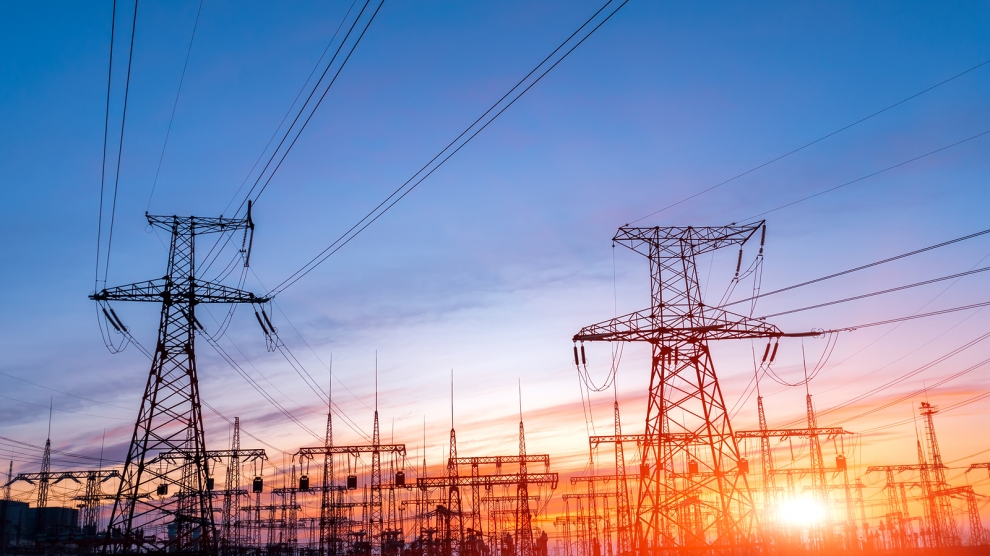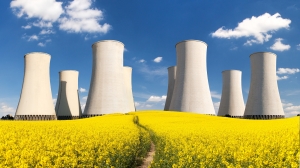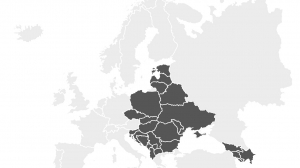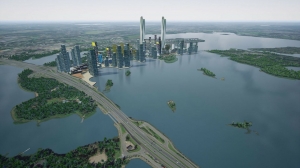Nearly three decades since the fall of the Iron Curtain, Russia continues to dominate emerging Europe’s energy markets. The Czech Republic, Hungary, Poland and Slovakia (known as the Visegrad Group, or V4) are just four of the region’s countries which still rely heavily on Russia as their sole supplier of imported natural gas, but they are not alone. Indeed, with the exception of Romania – which has the third largest natural gas reserves in the European Union after the Netherlands and United Kingdom – all of the region’s countries are exposed to varying extents.
In addition to an over-dependence on one source of fuel, the lack of an integrated emerging Europe regional energy market, infrastructure bottlenecks, and disagreements over implementation of a united energy policy has the potential to make the region even more vulnerable. Russia has stated its intention to reduce the amount of gas it sends through Ukraine for European deliveries to the lowest possible level from 2019, increasing energy concerns in the whole of emerging Europe. As such, a common gas market incorporating the V4 and neighbouring countries would have the potential to increase liquidity, enable more competitive prices and allow for market-based solutions to energy security issues.
In recent years, Poland has made efforts to wean itself off its dependency on its eastern neighbour. Simultaneously, Warsaw is taking steps towards meeting EU carbon targets by reducing its reliance on coal. Doing so, however, may put it at risk of blackouts in case of a particularly harsh winter. As other countries in the region, such as Slovakia, also reduce the amount of coal they burn, they expose themselves to similar strains on their energy supply. The need for emerging Europe to find alternative sources of energy has therefore never been more pressing.
The importance of interconnectors
Of the V4 countries, only Poland has its own sizeable natural gas resources and is, moreover, engaged in intensive extraction of shale gas. Changes in international markets and the emergence of new suppliers following the development of liquefied natural gas (LNG) will definitely have a significant impact on supply diversification, but, again, only Poland has taken any major steps in this direction with the construction of an LNG terminal at Świnoujście, a seaport on the Baltic Sea. Moreover, according to the BP Review of World Energy in 2015, the share of natural gas in Poland is 15 per cent, the lowest amongst the V4: it makes up 17 per cent of the energy mix in the neighbouring Czech Republic, 22 per cent in Slovakia while Hungary’s share is more than double that of Poland’s: 38 per cent.
In addition to the LNG terminal in Świnoujście, the construction of LNG terminals in Klaipėda, Lithuania and Krk, Croatia, allow for the physical diversification of supply and exploitation of the emerging global LNG market. Although Russia’s Gazprom still dominates the market, it is being forced to play in accordance with market rules, due to the construction of the LNG terminals and the “recently updated EU regulation on gas security of supply which introduces and enhances solidarity mechanisms to be used in case of crisis,” notes Maciej Jakubik, executive director at Central Europe Energy Partners (CEEP) — the first major organisation to represent the companies from the region’s energy sector at EU level.
Interconnectedness within the CEE region has strengthened, as it takes steps to wean itself off dependence on Russia, and significant progress has been made in increasing the security of the gas supply, particularly since the gas crisis of 2009.
“A key factor in this regard was the development of new systemic interconnectors and reverse flows on existing pipelines,” says Mr Jakubik. “A complex infrastructure development plan was conceptualised as the ‘North-South Gas Corridor’ and is consistently being pursued: the Slovak-Hungarian interconnector was launched in 2014, a Polish-Slovak interconnector went into construction and a final investment decision on the Baltic Pipe will be taken by the end of this year.”
Extending the EU’s internal energy market
Better interconnection can only work, however, if the energy market is extended beyond the EU’s current borders, a move which would increase competition and therefore stimulate investment.
Janez Kopač, director of the Energy Community, an international organisation which brings together the EU and its neighbours to create an integrated pan-European energy market, told Emerging Europe that the community works to “extend the EU internal energy market to South East Europe and beyond on the basis of a legally binding framework.” On the issue of the security of gas supply, Mr Kopač stated that, in gas, import substitution is impossible, but remains largely optimistic.
“Simply by opening of the market to Romanian gas, to gas from LNG terminals and gas from other sources being imported from [the Central European Gas Hub in] Baumgarten or elsewhere improves the security of supply situation. Azeri gas from the Trans Adriatic Pipeline (TAP) and the new interconnection between Greece and Macedonia will also improve the situation.”
Similarly, Mr Kopač noted that while extending the EU internal energy market to the south and east of the continent will not necessarily bring neither electricity nor gas into the region, it has the potential to “establish better conditions for investment in local renewables.”
Regarding the potential for renewable energy in the region, Mr Kopač believes that very high feed-in tariffs are triggering other ways of stopping investment in renewable projects, due to fears that the final price for consumers will end up being too high.
“Countries need to urgently start with auctions. Only Macedonia, Moldova and Albania have adopted proper laws and only Albania has organised a first auction. Success was enormous: they brought the feed-in tariff from 100 euros /MWh for PV down to less than 60 euros in one month,” said Mr Kopač.
Kosovo is grappling with the biggest dilemma, given that it is approximately 98 per cent dependent on coal. The Kosova authorities have already decided to build a coal power plant that they cannot attract financing for, despite state guarantees. The World Bank, which has decided to stop funding fossil fuel plants, pulled out of the project in early October 2018. Mr Kopač stated that the World Bank is offering to finance an alternative and cheaper project – a combination of wind energy, photovoltaics and batteries.
“I hope they will grab this opportunity and put themselves on the global map as a radical game changer,” added Mr Kopač.
Nuclear temptation
Not all CEE countries, however, are equally committed to diversifying and decarbonising their energy sources. Like the V4, Bulgaria is dependent on Russian energy, yet the Balkan country has repeatedly manifested its desire to build closer ties with Russia in the energy sector. For example, there are talks of restarting the mothballed Belene Nuclear Power Plant with Russian technology.
The country’s minister of economy and energy from 2009 to 2012, Traycho Traykov, is highly sceptical about Belene, the cost of which could be as much as 10 billion US dollars. He believes a second nuclear power plant in the country is economically unfeasible and will hinder the introduction of new technologies in the energy sector. In addition, a study conducted by the Bulgarian Academy of Sciences in 1990 concluded that Belene is located in an area with an increased risk of seismic activity. “I’m not an expert but I doubt that the geological structure of the region has changed much over the past 28 years,” added Mr Traykov. Given that Belene lies along the Bulgarian-Romanian border, this seismic risk has deeply concerned Romanian politicians as well. While a serving as an MEP, current Romanian Prime Minister Viorica Dăncilă called on the European Commission to oppose the Belene plant in light of the seismic danger.
In addition to these problems, a functioning Belene would likely to lead to the closure of the coal-fired power plants in the Maritsa East complex in southern Bulgaria, which Mr Traykov argues are vital sources of energy. The Maritsa East complex consists of three thermal power plants (TPPs) – two of them owned by American companies, ContourGlobal and AES, and one state-owned.
Professor Valentin Kolev of the Bulgarian Energy Chamber is a Bulgarian energy expert who recognises the benefits which the thermal power plants in the Maritsa East complex – TPP AES Galabovo and TPP Contour Global Maritsa East 3 – bring to the Bulgarian grid. Professor Kolev told Emerging Europe that without the generating capacities of the two plants (1,600 MW), “it is impossible to ensure the adequacy of the power system during the winter period.”
Bulgaria is not as well connected with its neighbours as Central European countries. Professor Kolev therefore believes that the only prudent solution to any serious curtailment of operations at the Maritsa plants would be to build substitute base capacities in the southeast of the country. In addition, Bulgaria would need to import electricity, most probably from neighbouring Turkey, during the winter period when the load of the power system exceeds 6,500 MW.
Bulgaria is also hoping to soon see benefits from the Gas Interconnector Greece-Bulgaria (IGB pipeline), which would connect Bulgaria to the Southern Gas Corridor. The IGB pipeline, which received approval from the Bulgarian and Greek governments in 2009, is expected to be completed by the first half of 2020. It will link Bulgaria to the Shah Deniz gas field in Azerbaijan and has the potential to significantly minimise Bulgaria’s dependence on Russian gas, allowing Bulgaria to balance its gas imports between Russian and Azeri suppliers. An additional alternative is to connect Bulgaria to the terminal on Krk. When completed, the terminal will allow for the import of LNG from an array of global suppliers, reducing Moscow’s economic leverage over Sofia.
Renewable energy lags behind
One option which has yet to materialise for much of emerging Europe is renewables. Given the current stage of technological development, argues Professor Kolev, electricity produced from renewables cannot replace the base capacities required for Bulgaria’s – or most other countries’ – power grid system. “Renewables are unable to provide the necessary static and dynamic stability of the power system,” he says. “Undoubtedly, we should be encouraging the development of decentralised renewable energy sources, smart electricity networks, energy efficiency and more. Increasing the installed photovoltaic power will result in surplus during the summer period and significant shortage in the winter, which raises the question of energy storage.”
When it comes to securing winter energy supply, Mr Kolev pointed to the need for power plants with hourly usability of an installed capacity of more than 6,000 hours (i.e. base stations).
“These base stations consist of conventional steam generator equipment, turbines and a synchronous generator with a large inertia mass. This is necessary for the more reliable and safer management of the power system. In addition, they are needed for securing the country’s power balance over the different seasons of the year,” he said.
Governments must take the lead
With energy consumers – particularly in the domestic sector – very price conscious across emerging Europe (even the smallest increases in energy prices can have a devastating impact on family budgets) the need for careful management of any pivot away from one source is clear. Governments must ensure that the most vulnerable are protected, using all instruments available to them.
As Mr Jakubik of Central Europe Energy Partners told Emerging Europe, “the drivers of diversification are governments. It is worth highlighting that the implementation of key projects (like pipelines) is very costly and might result in increases in tariffs for gas transportation. The EU facilitates diversification by financial means – the key instrument in this regard is Connecting Europe Facility (CEF) which provides substantial co-financing opportunities for cross-border energy projects. So overall it is reducing the cost of infrastructure investments.” Governments, via regulation, need to make sure that those reductions are fed back into the system to keep the energy price that end-users pay as low as possible.
Ensuring the security of emerging Europe’s energy supply through diversification will not happen overnight, but the long-term benefits are there to reap, for governments, investors and for consumers. But this can only happen in an environment where all stakeholders are included the process. Energy security is a problem that emerging Europe has given far too little attention for too long. With tensions between Russia and Ukraine mounting, the need for urgent action is great. It’s time for governments to demonstrate that they are ready, and capable, of meeting the challenge.






Add Comment